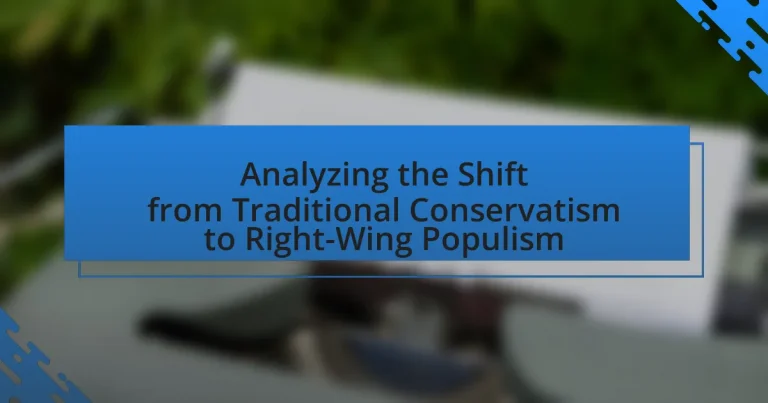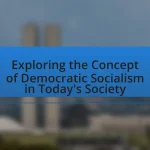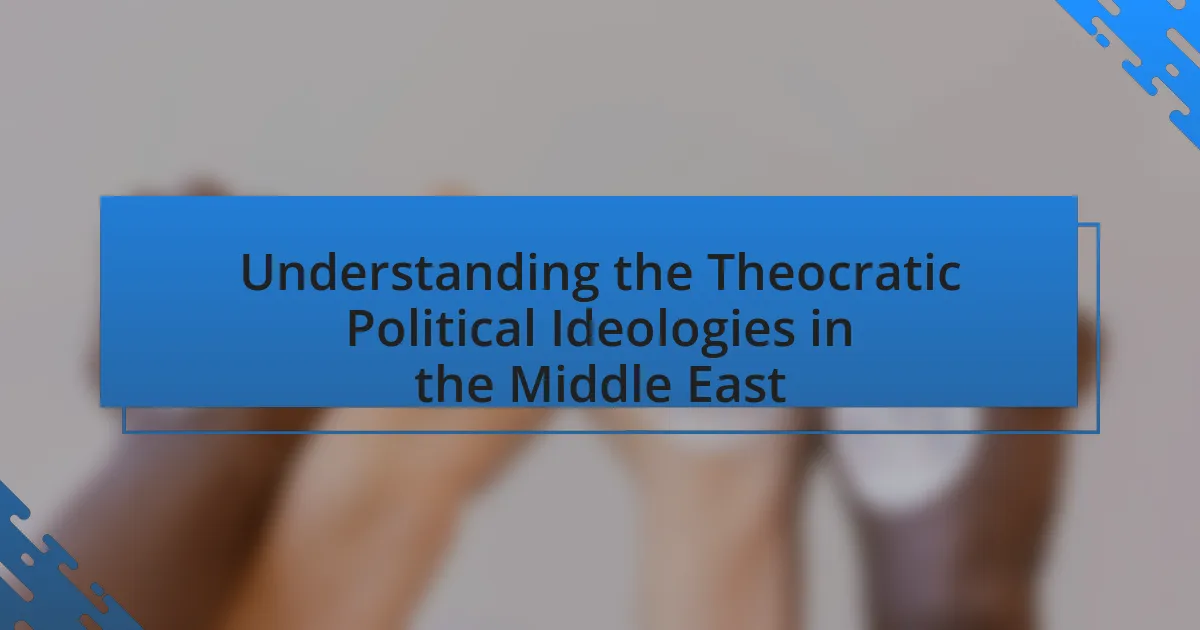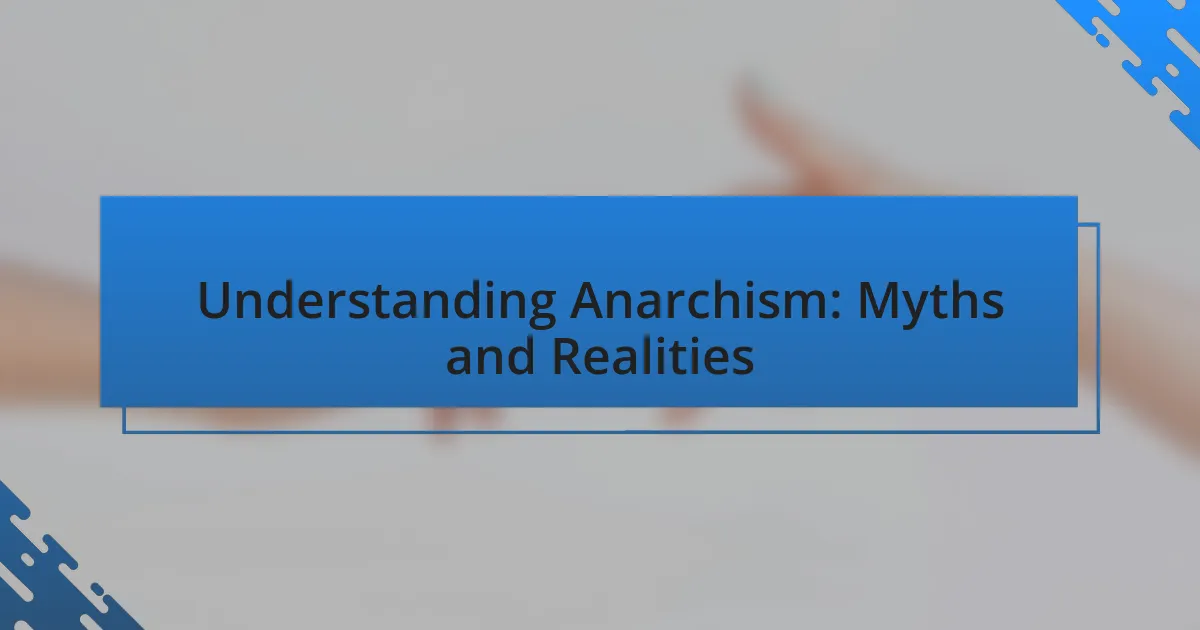The article analyzes the significant shift from traditional conservatism to right-wing populism, highlighting the transition from established conservative values to a populist approach that emphasizes nationalism and anti-elitism. It defines traditional conservatism, its core principles, and its evolution over time, while contrasting it with the characteristics of right-wing populism, including its focus on cultural identity and economic protectionism. The article also explores the social and political factors contributing to this shift, the implications for modern politics, and the challenges faced by traditional conservatives in adapting to the rise of populism. Key milestones and influential leaders in this transition are examined, along with lessons for future political movements.
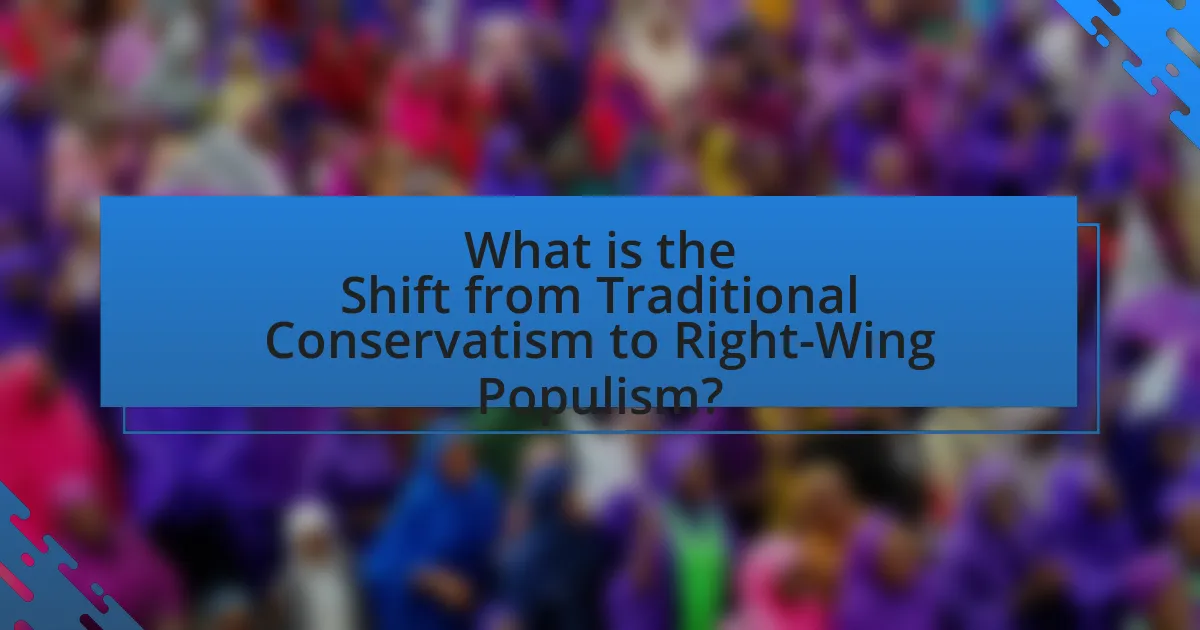
What is the Shift from Traditional Conservatism to Right-Wing Populism?
The shift from traditional conservatism to right-wing populism involves a transition from established conservative values, which emphasize free markets, limited government, and social order, to a populist approach that prioritizes nationalist sentiments, anti-elitism, and direct appeal to the “common people.” This change is evidenced by the rise of political figures and movements that reject traditional party structures and advocate for policies that resonate with public discontent, such as immigration restrictions and economic protectionism. For instance, the election of Donald Trump in 2016 marked a significant departure from conventional Republican ideals, as his campaign focused on populist rhetoric and a critique of the political establishment, reflecting a broader trend observed in various countries where right-wing populism has gained traction.
How do we define Traditional Conservatism?
Traditional Conservatism is defined as a political philosophy that emphasizes the importance of tradition, social stability, and maintaining established institutions. This ideology values gradual change over radical reform, advocating for a society rooted in historical continuity and moral order. Historically, Traditional Conservatism has been associated with figures such as Edmund Burke, who argued for the preservation of societal norms and customs as essential for maintaining social cohesion.
What are the core principles of Traditional Conservatism?
The core principles of Traditional Conservatism include a commitment to preserving established institutions, valuing social order, and emphasizing gradual change over radical reform. Traditional Conservatives believe in the importance of family, community, and religion as foundational elements of society, which they argue provide stability and moral guidance. Historically, figures like Edmund Burke have articulated these views, advocating for a respect for tradition and skepticism towards abstract ideologies that seek to reshape society fundamentally. This perspective is rooted in the belief that human nature is flawed and that societal structures should reflect this reality, promoting a cautious approach to governance and social change.
How has Traditional Conservatism evolved over time?
Traditional Conservatism has evolved from a focus on preserving established institutions and social hierarchies to incorporating elements of populism and nationalism. Initially, Traditional Conservatism emphasized stability, gradual change, and respect for tradition, as seen in the works of Edmund Burke in the 18th century, who argued for the importance of societal continuity. Over time, particularly in the late 20th and early 21st centuries, Traditional Conservatism began to adapt to changing social dynamics, responding to economic globalization and cultural shifts. This adaptation included a growing emphasis on individualism and market-oriented policies, as well as a reaction against perceived threats from immigration and multiculturalism. The rise of right-wing populism has further transformed Traditional Conservatism, as seen in the political strategies of leaders like Donald Trump, who blend traditional conservative values with populist rhetoric, appealing to a broader base by addressing economic anxieties and national identity concerns.
What characterizes Right-Wing Populism?
Right-wing populism is characterized by its appeal to nationalism, anti-elitism, and a focus on preserving traditional cultural values. This political ideology often positions itself against established political elites, claiming to represent the “common people” against a corrupt system. Right-wing populist movements frequently emphasize issues such as immigration control, national sovereignty, and economic protectionism, arguing that these measures are necessary to protect the interests of the nation and its citizens. Historical examples include the rise of leaders like Donald Trump in the United States and Marine Le Pen in France, who have successfully mobilized support by tapping into public discontent with globalization and immigration policies.
What are the key features of Right-Wing Populism?
Right-wing populism is characterized by its emphasis on nationalism, anti-elitism, and a focus on cultural identity. Nationalism manifests through the prioritization of the interests of the native population over immigrants, often accompanied by calls for stricter immigration controls. Anti-elitism is evident in the rejection of established political elites and institutions, portraying them as corrupt and disconnected from the common people. Additionally, right-wing populism often promotes a narrative that emphasizes the preservation of traditional values and cultural heritage, which can lead to resistance against globalization and multiculturalism. These features are supported by various political movements and leaders, such as Donald Trump in the United States and Marine Le Pen in France, who have successfully mobilized public sentiment around these themes.
How does Right-Wing Populism differ from Traditional Conservatism?
Right-wing populism differs from traditional conservatism primarily in its emphasis on anti-establishment sentiment and direct appeal to the “common people.” While traditional conservatism focuses on maintaining established institutions, values, and gradual change, right-wing populism often rejects these institutions, portraying them as corrupt and out of touch with the populace. For example, right-wing populist leaders like Donald Trump have utilized rhetoric that directly challenges political elites and mainstream media, positioning themselves as champions of the ordinary citizen. This approach is supported by the rise of populist movements in various countries, which have gained traction by addressing economic anxieties and cultural grievances that traditional conservatism may overlook.
Why is the shift from Traditional Conservatism to Right-Wing Populism significant?
The shift from Traditional Conservatism to Right-Wing Populism is significant because it represents a fundamental change in political ideology and voter alignment, reflecting a growing discontent with established political elites. This transition has been marked by the rise of leaders who prioritize nationalist sentiments, anti-immigration policies, and economic protectionism, appealing directly to the frustrations of the working and middle classes. For instance, the election of Donald Trump in the United States and the Brexit vote in the United Kingdom exemplify how Right-Wing Populism has mobilized voters who feel marginalized by globalization and traditional political structures. This shift has reshaped party dynamics, leading to increased polarization and a redefinition of political discourse, as evidenced by the decline of centrist parties and the rise of populist movements across Europe and North America.
What social and political factors have contributed to this shift?
The shift from traditional conservatism to right-wing populism has been significantly influenced by economic inequality and cultural backlash. Economic inequality has fueled discontent among working-class voters, leading them to embrace populist leaders who promise to prioritize their interests over elite concerns. For instance, the 2008 financial crisis exacerbated wealth disparities, prompting a rise in populist sentiments as individuals sought alternatives to established political parties. Additionally, cultural backlash against immigration and globalization has mobilized support for right-wing populism, as many perceive these factors as threats to national identity and social cohesion. This phenomenon is evidenced by the electoral successes of populist parties in various countries, such as the Brexit vote in the UK and the election of Donald Trump in the United States, both of which were driven by a desire to reclaim national sovereignty and address perceived cultural grievances.
How does this shift impact political discourse and policy-making?
The shift from traditional conservatism to right-wing populism significantly alters political discourse and policy-making by prioritizing nationalist rhetoric and anti-establishment sentiments. This transformation leads to a focus on issues such as immigration, national sovereignty, and economic protectionism, often sidelining traditional conservative values like fiscal responsibility and free-market principles. For instance, the rise of populist leaders in various countries has resulted in policies that emphasize border control and trade barriers, reflecting a departure from previous conservative approaches that favored globalization. This shift has been evidenced by the electoral success of populist parties in Europe and the United States, where they have reshaped the political landscape and influenced mainstream parties to adopt more populist stances.
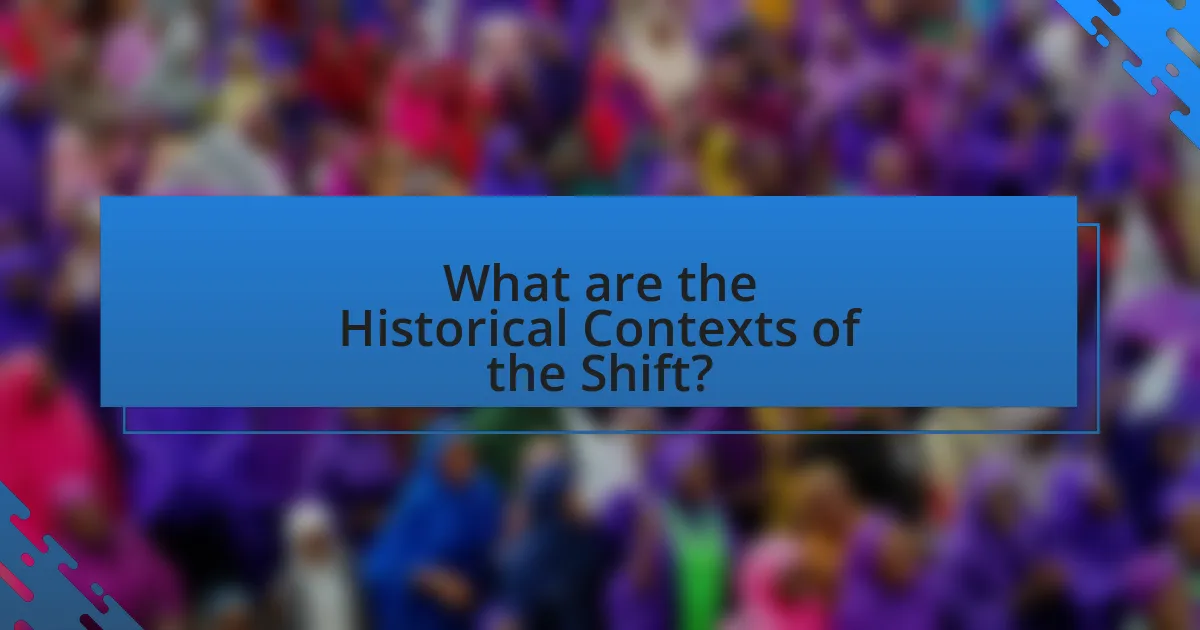
What are the Historical Contexts of the Shift?
The historical contexts of the shift from traditional conservatism to right-wing populism include economic crises, social changes, and political disillusionment. Economic downturns, such as the 2008 financial crisis, led to widespread dissatisfaction with established political parties, prompting a rise in populist sentiments. Social changes, including increased immigration and cultural shifts, fueled fears among certain demographics, which right-wing populist movements capitalized on by promoting nationalist and anti-immigrant rhetoric. Additionally, political disillusionment with traditional conservative parties, perceived as out of touch with the needs of the populace, created a fertile ground for populist leaders who promised to represent the “common people” against the elite. These factors collectively contributed to the emergence and popularity of right-wing populism in various countries.
How have historical events influenced the rise of Right-Wing Populism?
Historical events have significantly influenced the rise of Right-Wing Populism by creating socio-economic conditions that foster discontent among the populace. For instance, the 2008 financial crisis led to widespread economic instability, job losses, and a growing sense of disenfranchisement, which populist leaders exploited by blaming elites and advocating for nationalist policies. Additionally, the migration crises in Europe and the United States have intensified fears about cultural identity and economic competition, further galvanizing support for right-wing populist movements. The Brexit referendum in 2016 exemplifies this trend, as it was driven by a desire to reclaim sovereignty and control over immigration, reflecting a broader reaction against globalization and perceived threats to national identity. These historical events have collectively shaped a political landscape where Right-Wing Populism can thrive by appealing to the frustrations and fears of the electorate.
What role did economic crises play in this transition?
Economic crises significantly accelerated the transition from traditional conservatism to right-wing populism by creating widespread discontent and eroding trust in established political institutions. For instance, the 2008 financial crisis led to increased unemployment and economic instability, prompting voters to seek alternatives to mainstream parties. This shift is evidenced by the rise of populist leaders who capitalized on economic grievances, such as Donald Trump in the United States and Marine Le Pen in France, both of whom gained support by promising to address the economic concerns of disaffected citizens. The economic downturns thus acted as catalysts, enabling right-wing populist movements to gain traction by framing themselves as champions of the “common people” against the elite.
How did cultural changes contribute to the shift?
Cultural changes significantly contributed to the shift from traditional conservatism to right-wing populism by altering societal values and priorities. The rise of individualism, driven by globalization and technological advancements, led to a growing disconnection from established institutions and traditional norms. This shift fostered an environment where populist leaders could capitalize on feelings of disenfranchisement and cultural anxiety, often framing their messages around nationalism and anti-elitism. For instance, the increasing visibility of multiculturalism and immigration challenged traditional conservative views, prompting a backlash that right-wing populists effectively harnessed to gain support.
What are the key milestones in the evolution from Traditional Conservatism to Right-Wing Populism?
The key milestones in the evolution from Traditional Conservatism to Right-Wing Populism include the rise of neoliberal economic policies in the late 20th century, the reaction against globalization, and the emergence of charismatic populist leaders. Neoliberalism, which gained prominence in the 1980s, shifted conservative focus from social issues to economic deregulation and free markets, alienating some traditional conservatives. The backlash against globalization in the 2000s, characterized by economic dislocation and cultural anxiety, fueled populist sentiments that rejected elite consensus. Additionally, the success of leaders like Donald Trump in the United States and Marine Le Pen in France exemplified the shift, as they combined nationalist rhetoric with anti-establishment themes, appealing directly to the frustrations of the working and middle classes. These milestones collectively illustrate the transformation of conservative ideology into a more populist and nationalist framework.
Which political movements marked significant turning points?
The political movements that marked significant turning points include the rise of the Tea Party in the United States, the Brexit campaign in the United Kingdom, and the emergence of populist parties across Europe, such as Italy’s Lega Nord and France’s National Rally. The Tea Party, which gained prominence in 2009, reshaped the Republican Party by emphasizing limited government and fiscal conservatism, leading to a shift towards more extreme right-wing policies. Brexit, voted on in 2016, represented a significant rejection of traditional political norms and globalization, influencing similar nationalist movements worldwide. Additionally, the success of populist parties in Europe has challenged established political structures, reflecting a broader trend towards right-wing populism that prioritizes national sovereignty and anti-immigration sentiments. These movements collectively illustrate a transformative shift from traditional conservatism to a more populist and nationalist political landscape.
How did influential leaders shape this transition?
Influential leaders shaped the transition from traditional conservatism to right-wing populism by redefining political narratives and mobilizing grassroots support. Leaders such as Donald Trump in the United States and Jair Bolsonaro in Brazil utilized rhetoric that emphasized nationalism, anti-elitism, and a rejection of established political norms, which resonated with disaffected voters. For instance, Trump’s campaign in 2016 focused on themes like immigration control and economic protectionism, appealing to voters who felt marginalized by globalization and traditional conservative policies. This shift was evidenced by the significant electoral successes of these leaders, which reflected a broader trend of populist sentiment gaining traction in various democracies, as seen in the rise of similar movements across Europe.
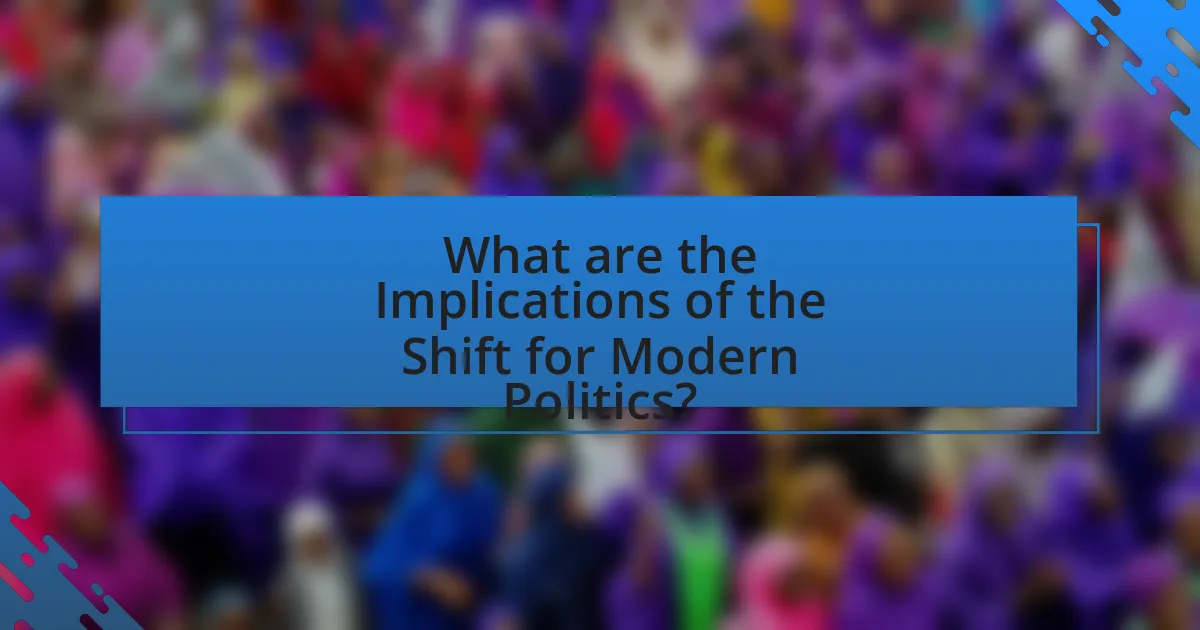
What are the Implications of the Shift for Modern Politics?
The shift from traditional conservatism to right-wing populism has significant implications for modern politics, primarily altering party dynamics and voter engagement. This transition has led to the rise of populist leaders who prioritize nationalist sentiments and anti-establishment rhetoric, often appealing to emotions over policy details. For instance, the election of Donald Trump in the United States exemplifies how populism can reshape political discourse, attracting disenchanted voters by promising to address their grievances against the political elite. Additionally, this shift has resulted in increased polarization within political parties, as traditional conservatives struggle to reconcile their values with the more radical positions of populist factions. Research by Cas Mudde and Cristóbal Rovira Kaltwasser highlights that right-wing populism often thrives in contexts of economic uncertainty and cultural anxiety, further complicating the political landscape.
How does the shift affect voter behavior and party dynamics?
The shift from traditional conservatism to right-wing populism significantly alters voter behavior and party dynamics by increasing voter engagement among disillusioned demographics. This transformation often leads to a realignment of party bases, as populist rhetoric attracts individuals who feel marginalized by mainstream politics. For instance, in the United States, the rise of Donald Trump in 2016 mobilized working-class voters who previously supported Democrats, demonstrating a shift in allegiance based on economic grievances and anti-establishment sentiments. This change in voter behavior pressures traditional parties to adapt their platforms, often resulting in a more polarized political landscape where populist parties gain influence, reshaping the overall dynamics within the political system.
What demographic changes are associated with Right-Wing Populism?
Demographic changes associated with Right-Wing Populism include a rise in support among working-class individuals, particularly those with lower educational attainment, and a notable shift in voting patterns among older populations. Research indicates that these groups often feel economically marginalized and culturally threatened, leading them to gravitate towards populist leaders who promise to address their grievances. For instance, in the United States, the 2016 presidential election saw significant support for Donald Trump among white working-class voters, a demographic that traditionally leaned Democratic. This shift is further evidenced by studies showing that areas with higher unemployment rates and declining industries tend to favor right-wing populist parties, highlighting the correlation between economic distress and the appeal of populist rhetoric.
How do political parties adapt to the rise of Right-Wing Populism?
Political parties adapt to the rise of Right-Wing Populism by shifting their platforms to incorporate populist themes, emphasizing nationalism, and addressing public concerns about immigration and economic inequality. For instance, traditional conservative parties in Europe have adopted stricter immigration policies and anti-establishment rhetoric to resonate with populist sentiments, as seen in the strategies of parties like the Austrian Freedom Party and Italy’s League. This adaptation is often driven by electoral pressures, where parties seek to capture the growing voter base that feels disillusioned with mainstream politics, evidenced by the significant electoral gains made by populist parties in recent elections across various countries.
What challenges does this shift pose for Traditional Conservatism?
The shift from Traditional Conservatism to Right-Wing Populism poses significant challenges for Traditional Conservatism, primarily in terms of ideological coherence and electoral viability. Traditional Conservatism emphasizes principles such as limited government, fiscal responsibility, and social stability, which can be undermined by the populist focus on nationalism and anti-establishment sentiments. This ideological divergence can alienate moderate conservatives who prioritize traditional values and institutional integrity. Additionally, the rise of populism often leads to a fragmentation of the conservative voter base, as populist leaders appeal to emotions and grievances rather than established conservative policies, making it difficult for Traditional Conservatives to maintain electoral support. Historical examples, such as the Brexit referendum and the election of Donald Trump, illustrate how populist movements can reshape political landscapes, challenging the relevance and influence of traditional conservative platforms.
How can Traditional Conservatives respond to the rise of Right-Wing Populism?
Traditional Conservatives can respond to the rise of Right-Wing Populism by reaffirming their core principles while addressing the concerns that populist movements exploit. They should emphasize the importance of established institutions, rule of law, and fiscal responsibility, which are foundational to traditional conservatism. By engaging in open dialogue with disaffected voters, Traditional Conservatives can acknowledge economic anxieties and cultural shifts that fuel populist sentiments, thereby offering pragmatic solutions rather than dismissive rhetoric. Historical examples, such as the Conservative Party in the UK adapting its policies in response to the Brexit movement, illustrate how traditional parties can recalibrate their platforms to remain relevant while maintaining their ideological integrity.
What strategies can be employed to bridge the gap between the two ideologies?
To bridge the gap between traditional conservatism and right-wing populism, fostering dialogue and understanding between the two ideologies is essential. This can be achieved through organized forums and discussions that encourage representatives from both sides to articulate their values and concerns, promoting mutual respect. Research indicates that such engagement can reduce polarization; for instance, a study by the Pew Research Center found that open dialogues can lead to increased empathy and understanding among differing political groups. Additionally, creating coalitions around shared goals, such as economic stability or national security, can unite both ideologies, allowing for collaborative efforts that respect the core principles of each side while addressing common challenges.
What lessons can be learned from the shift for future political movements?
The shift from traditional conservatism to right-wing populism teaches future political movements the importance of addressing economic anxieties and cultural identity. Political movements that effectively resonate with the public’s concerns about job security and immigration can mobilize significant support, as evidenced by the rise of populist leaders in various countries. For instance, the success of Donald Trump in the 2016 U.S. presidential election demonstrated how appealing to voters’ fears and frustrations can lead to electoral victories. Additionally, movements should leverage social media to engage directly with constituents, as seen in the campaigns of populist parties across Europe, which utilized platforms to bypass traditional media and connect with voters.
How can emerging political movements avoid pitfalls seen in this shift?
Emerging political movements can avoid pitfalls seen in the shift from traditional conservatism to right-wing populism by prioritizing clear communication and maintaining a focus on inclusive policies. Clear communication helps to articulate their values and goals effectively, reducing the risk of misinterpretation and backlash, as evidenced by the challenges faced by movements that failed to convey their messages clearly, leading to public distrust. Additionally, inclusive policies can prevent alienation of diverse voter bases, which is crucial since right-wing populism often thrives on division. Historical examples, such as the decline of certain populist movements that became too extreme or exclusionary, demonstrate that maintaining a broad appeal is essential for sustained support.
What best practices can be adopted from this transition?
Best practices that can be adopted from the transition from traditional conservatism to right-wing populism include enhancing grassroots engagement, prioritizing clear communication of core values, and leveraging social media for outreach. Grassroots engagement fosters a stronger connection with constituents, as evidenced by the success of populist movements that mobilize local support. Clear communication of core values helps to differentiate populist platforms from traditional conservatism, ensuring that messages resonate with a broader audience. Additionally, the effective use of social media has been shown to amplify messages rapidly, as seen in the campaigns of various right-wing populist leaders who have utilized these platforms to reach and mobilize supporters efficiently.
